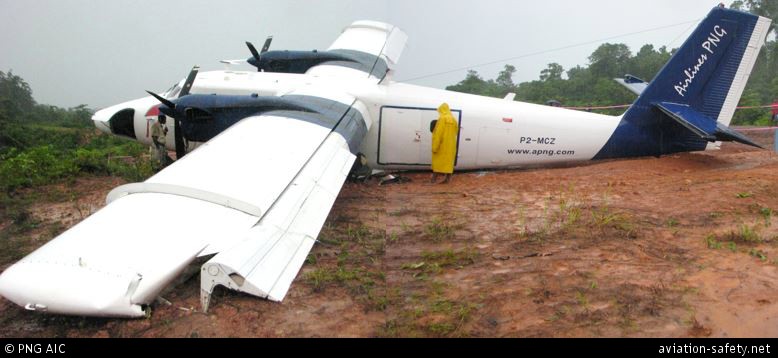
| Date: | Tuesday 15 May 2012 |
| Time: | 12:40 |
| Type: |  de Havilland Canada DHC-6 Twin Otter 300 |
| Owner/operator: | Airlines PNG |
| Registration: | P2-MCZ |
| MSN: | 330 |
| Year of manufacture: | 1971 |
| Total airframe hrs: | 50168 hours |
| Engine model: | Pratt & Whitney Canada PT6A-27 |
| Fatalities: | Fatalities: 0 / Occupants: 16 |
| Aircraft damage: | Substantial, repaired |
| Category: | Accident |
| Location: | Sasereme Airstrip -
 Papua New Guinea Papua New Guinea
|
| Phase: | Landing |
| Nature: | Passenger - Scheduled |
| Departure airport: | Port Moresby-Jacksons International Airport (POM/AYPY) |
| Sasereme Airstrip | |
| Investigating agency: | AIC PNG |
| Confidence Rating: |
A de Havilland DHC-6 Twin Otter aircraft, registered P2-MCZ, departed Port Moresby-Jackson's Airport at 01:40 UTC for Sasereme. It was a regular public transport flight that had been planned to refuel at Sasereme and continue to Balimo and on to Daru. For the flight to Sasereme, the pilot in command (PIC) was the support/monitoring pilot, and the copilot was the handling pilot. The aircraft arrived over the Saserema airstrip at 02:40. While en-route, the crew was informed by the company flight operations staff that it had been raining at Sasereme throughout the previous night until morning, but the prevailing weather was fine.
The flight was being conducted under the visual flight rules (VFR) procedures. The copilot had not flown into Sasereme before, so this was a training flight for her. During the cruise before top of descent, the crew discussed the approach and landing requirements. Because of the wet, slippery and rough airstrip surface conditions and a landing weight of 5,300 kg, they agreed on a 30 degrees flap settings and a approach speed of 73 knots.
The weather, as observed by the crew, was sunny and fine with few clouds around and the wind was estimated to be light and variable (2 to 3 kt) even though there was no wind sock available to indicate the actual wind velocity. The crew opted to land on strip 14 and joined the circuit on left downwind.
Passing through 50 ft the copilot flared the aircraft and it floated in ground effect. As the main landing gear touched down on the centreline of the strip it skipped, became airborne and stayed in ground effect for at least another 20 m. On the second touchdown the aircraft yawed to the left and at that point the PIC took over the controls and applied full reverse thrust. He applied right rudder to regain the centreline, but at the same time the left main landing gear started impacting the ruts in the surface of the strip, severely degrading directional control.
The PIC subsequently reported that at that point he felt it was not safe to apply power for an aborted landing. He moved the left power lever out of reverse while keeping full reverse and right rudder input on the right engine and began pulsing the brakes. The left main wheel continued impacting more ruts as the aircraft decelerated. Eventually the left main wheel hit a deep rut pulling the aircraft sharply to the left off the runway.
That partially dislodged the landing gear from the airframe causing the left wing to impact the ground. The aircraft came to rest about 5 m from the edge of the airstrip. The PIC shut down the engines while the copilot assisted the passengers from aircraft through the right rear cabin door.
The investigation determined that the decision to operate into Sasereme on a scheduled air service, without knowing the serviceability of the strip, was a safety deficiency in the operation of the aircraft and contributory factor in the accident.
The PIC did not provide the copilot with the opportunity to observe an approach and landing at Sasereme before allowing her to handle a landing there as pilot flying.
The PIC's late decision to take control of the aircraft from the copilot and execute a go-around was also a contributory factor.
Accident investigation:
 |
|
Sources:
Location
Images:

photo (c) PNG AIC; Sasereme Airstrip; May 2012

photo (c) PNG AIC; Sasereme Airstrip; May 2012

photo (c) PNG AIC; Sasereme Airstrip; May 2012
Revision history:
| Date/time | Contributor | Updates |
|---|
The Aviation Safety Network is an exclusive service provided by:


 ©2024 Flight Safety Foundation
©2024 Flight Safety Foundation